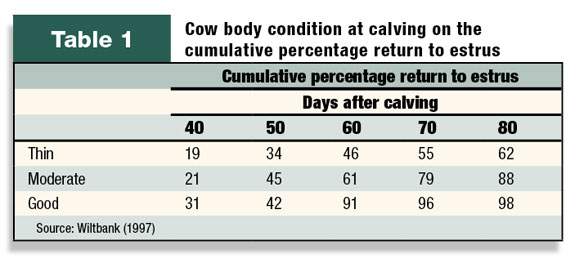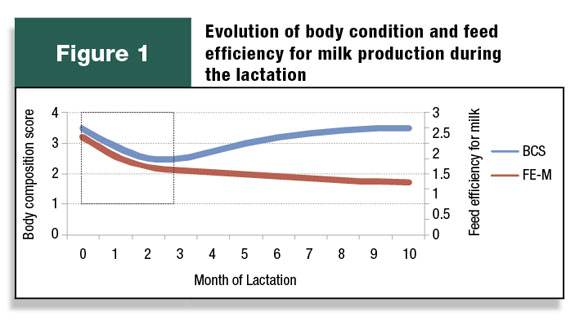Changes in bodyweight are not a very good indicator of the nutritional status of dairy cows. For example, while the gut contents of a 1,400-lb dairy cow weigh approximately 200 lbs, the cow has a daily intake of nearly 100 lbs of feed (fresh weight) and 160 to 240 lbs of water (one gallon equals 8 lbs).
In addition, the cow outputs over 120 lbs of fresh manure and urine per day, as well as 50 to 100-plus lbs of milk. Thus, the ability to accurately depict actual changes in body mass via bodyweight measurements can be affected by daily fluctuations in bodyweight.
A better method of evaluating the nutritional status of cows is through its body condition score (BCS).
Body condition scoring, while subjective, is a useful and practical visual assessment tool of the nutritional status of cattle. High percentages of repeatability, both between measurements and between scorers, can be obtained with practice.
The scoring system usually in use for dairy cattle is a five-point scale, with 1 corresponding to an extremely thin cow, and 5 to a cow with excessive fat deposits. Photos of and a text description for each body condition score are provided at the conclusion of this publication.
High feed costs may sometimes lead to poor decisions when it comes to selecting feedstuffs for cattle at different physiological states. In general, in an attempt to maximize returns on feed dollars, high-producing dairy cows are offered the best feeds available. Similarly, to decrease overall feed costs, far-off dry cows are usually fed low-quality forages.
The latter approach, especially if extremely low-quality forages are fed, negatively affects the resumption of the cow’s reproductive activity right after calving, while also increasing the incidence of health-related disorders. Body condition score can be used routinely both to assess the nutritional status of different cattle feeding groups and to determine the right feed allocation (where it will have the greatest effect on income over feed costs).
Body condition and post-calving ovarian activity
For the first 4 to 6 weeks after calving, the cow’s feed intake does not increase as fast as milk production does, which results in the mobilization of body stores. Thus, during the first two months of lactation, the extent to which a cow will lose body condition is determined by the balance between her nutrient uptake and her genetic potential for milk production.

According to the NRC, the equilibrium between tissue mobilization and accretion in an adequately fed cow can occur at approximately 60 days post-calving. Achieving this equilibrium as soon as possible is of importance because of the related increases in the percent of cows that resume ovarian cyclic activity ( Table 1 ).
A faster return to ovarian cyclic activity is critically important because it both allows producers to shorten the voluntary waiting period (calving to first insemination) and reduces the calving interval. It has been demonstrated that the BCS recorded one month after calving had the largest correlation with calving interval, particularly in first-lactation cows.
Similarly, high-producing cows with low BCS five weeks or more after calving can be expected to have delayed estrus resumption. Cows with poor BCS had fewer normal oocytes than cows with higher scores, whereas follicle numbers were higher in cows with BCS of 3 to 5.
Body condition and cow health
An adequate body condition is very important for the maintenance of an animal’s production, reproduction and overall health. If improving body condition score to the optimum increases fertility, excessive condition can result in metabolic problems, particularly in close-up cows.
Fatty liver can occur shortly before and after calving, during what has been termed “transition period.”When faced with a reduction in intake, a cow mobilizes body fat, which increases both the concentration of circulating fatty acids and the fat deposits in the liver. Dry cows with body condition of 3 or less can be fed more energy in the diet to improve their condition with less risk of fatty liver.
The risk is less because the liver does not deposit fat while in positive energy balance. On the other hand, the efficiency of depositing energy is greater while in lactation, so it is more important both to achieve a desired body condition before dry-off and to maintain the body condition from then through calving.
Overconditioned cows should not be “feed restricted,” as fat would be mobilized from adipose tissue – which will increase circulating fatty acids and, in turn, increase fat deposits in the liver. As many as 50 percent of the cows in many dairy herds have fatty liver.Fatty liver both negatively affects the outcome of other metabolic diseases (in particular, displaced abomasum and ketosis) and increases the cost of production.
Kelton et. al. suggested that clinical ketosis costs U.S. dairy farmers $62,640,000 yearly (4 percent to 8 percent incidence per herd, and $145 per case). Fatty liver is also associated with increased incidences and severity of laminitis, mastitis, milk fever, retained placenta and metritis. In the long term, increased liver fat concentrations are associated with decreased reproductive success and decreased milk production in dairy cows.
Feeding for body condition score
With high feed prices, a logical approach is to take a closer look at the efficiency of feed utilization (with the implication being that less feed may be used by an animal to produce the same amount of product). One problem is that improvements in feed efficiency early in lactation are heavily biased towards greater body energy mobilization compared to the feed energy supply.

Figure 1 shows the evolution of suggested BCS and feed efficiency for milk production during an entire lactation.
Early in lactation, feed efficiency for milk production is artificially high (2.4) and results from a low initial feed intake paired with body fat mobilization.
As a result, once feed intake starts to increase, in the first two months of lactation, the feed efficiency for milk production sharply decreases (hand-in-hand with increased feed intake); and feed efficiency continues to decrease through the remainder of the lactation.
After eight weeks of lactation, the energy supplied by the feed tends to match that required for milk production. At this time, the cow starts to gain condition, whereas feed efficiency for milk production continues to drop steadily; this is represented by the two divergent lines in Figure 1.
Improving feed efficiency without taking a close look at body condition can thus negatively impact fertility, productivity and overall animal health. In addition, feeding for body condition is very important to reduce the incidence of health problems. It has been suggested that a 1 percent increase in the variation of dry matter intake increases the likelihood of post-calving incidents by 4 percent.
Cows should end their lactation in the body condition that would be desirable at calving (e.g., 3.5) to avoid the need to add weight during the dry-off period. Body condition in excess of 3.5 to 3.75 during the dry period can lead to increased incidences of fat cow syndrome and fatty livers at calving, compared with condition gained during lactation.
On the other hand, underfeeding dry cows, either to make them lose excessive weight and/or as a result of feeding low-quality forages or feed restriction, can lead to body fat mobilization and increase incidence of ketosis.
It is important to take into consideration cattle socialization as it relates to BCS. When first-lactation and later-lactation animals are grouped together, they usually compete for available space. If BCS is to be maintained during the dry period, it is very important to ensure that there is enough feedbunk, water and stall space for each cow.
Feedstuffs used in the formulation of far-off dry cows are usually of lower digestibility/energy content. Differentiation has to be made between low quality due to less total digestible nutrients and low quality due to the presence of contaminants such as weeds and/or fungi growth. Feeds unacceptable for lactating dairy cows should also be questionable for dry animals.
“Off-smells” due to contaminants oftentimes result in feed refusal, sorting and/or uneven ration intake, all of which can affect BCS. Animals that have maintained adequate condition through the dry period can then possibly lose condition as a result of selective feeding.
Diets fed to dry cows should be balanced and palatable and formulated for a transition between the far-off dry period and early lactation. Moderately increase grain in the diet right before calving to increase the energy density of the ration, and reduce body condition losses right after calving.
Even when all these measures are considered, energy demands early in lactation will lead to some body store losses, particularly in the form of fat. One important measure is to manage rations for consistency of feed intake early in the lactation. PD
References omitted due to spacebut are available upon request to editor@progressivedairy.com .
—Excerpts from South Dakota State University Extension Extra newsletter; ExEx4040, June 2008

-
Alvaro Garcia DVM, Ph.D.
- Associate Professor
- South Dakota State University
- Email Alvaro Garcia DVM, Ph.D.






